Living with a roommate or sharing a space with a partner doesn’t mean you have to sacrifice style, comfort, or privacy. In fact, I’ve discovered that designing a room with two beds can be one of the most rewarding interior design challenges—it pushes you to think creatively about space, functionality, and personal expression all at once.
Whether you’re dealing with a studio apartment, a guest room that needs to accommodate multiple visitors, or simply want to create separate sleeping spaces in a shared bedroom, the key lies in thoughtful planning and smart design choices. I’ve seen countless adults transform their shared sleeping quarters from cramped and chaotic to stylish and serene with just a few strategic moves.
The modern approach to dual-bed rooms has evolved far beyond the basic “two beds pushed against opposite walls” setup. Today’s designs embrace everything from sophisticated storage solutions to clever visual tricks that make spaces feel larger and more luxurious. You’ll discover how to create distinct personal zones while maintaining a cohesive aesthetic that works for both occupants.
In this guide, I’ll walk you through 10 innovative approaches that maximize both style and functionality. From space-saving layouts that optimize every square foot to design elements that provide privacy without closing off the room, these ideas will help you create a shared bedroom that feels intentional, comfortable, and uniquely yours. Get ready to transform your shared space into a retreat that works beautifully for everyone involved.
1. Bunk Beds Reimagined for Adults
Gone are the days when bunk beds were just for kids’ rooms. I’ve seen stunning adult bunk bed setups that maximize vertical space while creating a sophisticated, hotel-like atmosphere. Modern adult bunk beds feature sturdy construction, built-in lighting, and privacy curtains that transform each level into a personal sanctuary. The key is choosing designs with clean lines, quality materials like solid wood or metal, and adult-friendly features such as wider mattress sizes and integrated storage. Consider models with built-in desks underneath the lower bunk or reading nooks that double as workspace areas. This approach works exceptionally well in studio apartments or rooms with high ceilings, where you can take advantage of vertical real estate.
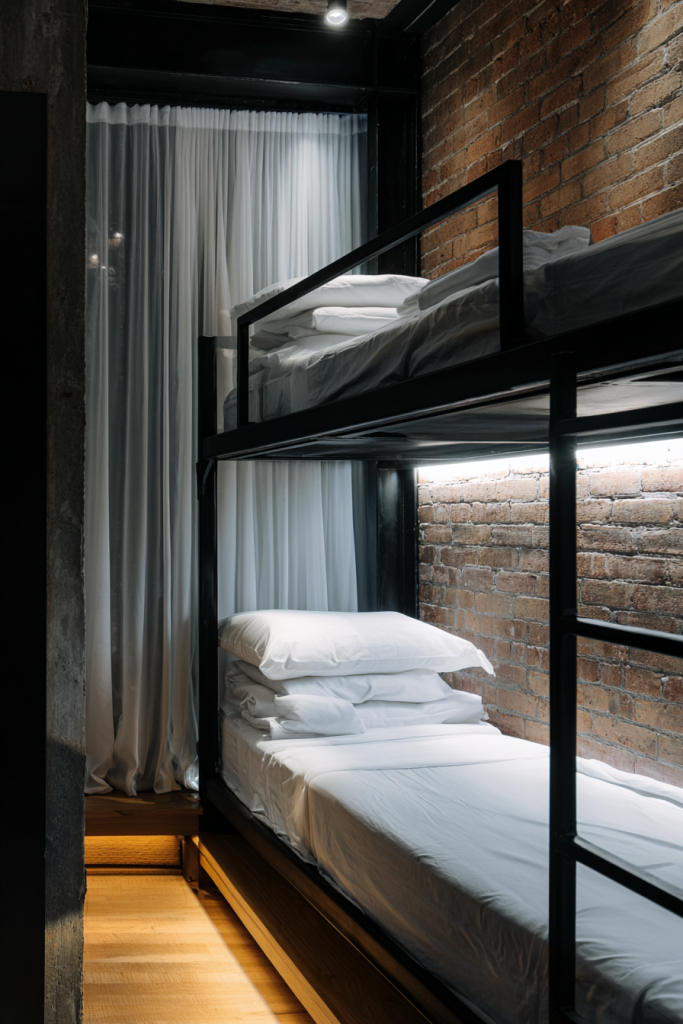
2. L-Shaped Layout for Maximum Floor Space
An L-shaped bed configuration is one of my favorite solutions for awkwardly shaped rooms or when you want to create distinct zones within the space. By positioning beds perpendicular to each other in a corner arrangement, you free up the center of the room for other furniture or activities. This layout naturally creates separate personal areas while maintaining an open feel. I recommend using matching headboards or bed frames to maintain visual cohesion, then differentiating each space with unique bedding colors or patterns. Add a shared nightstand or small bookshelf at the corner junction to bridge the two sleeping areas. This configuration works particularly well when one bed is positioned against a window for natural light access.
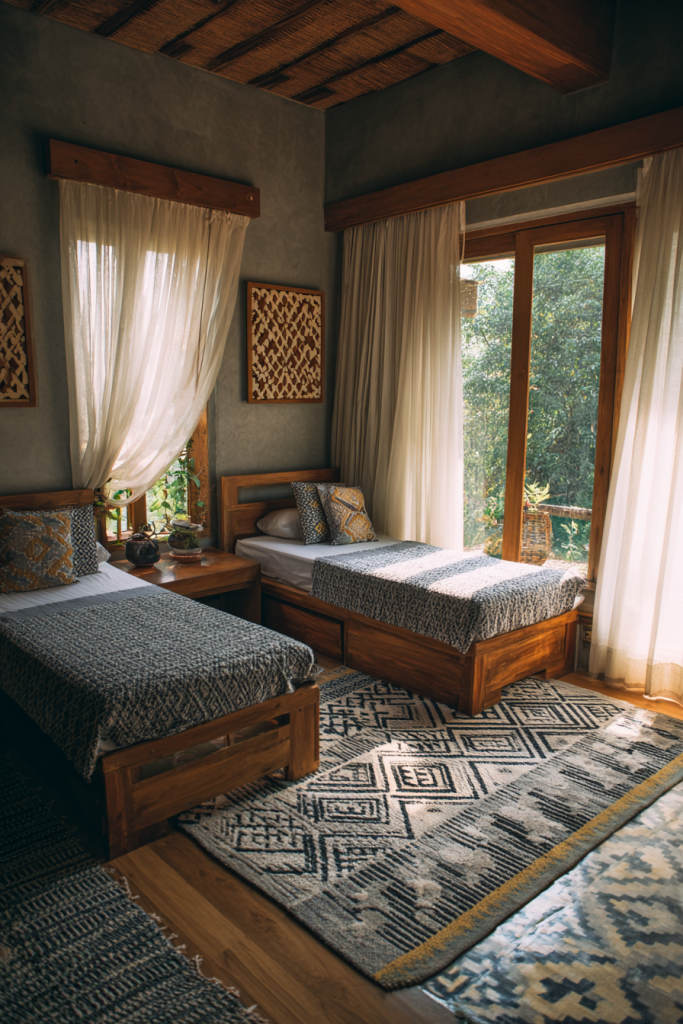
3. Platform Beds with Built-In Storage
Storage is crucial in any shared bedroom, and platform beds with integrated drawers or compartments are game-changers for organization. I always recommend these to clients because they eliminate the need for additional storage furniture, keeping the room feeling spacious and uncluttered. Look for platform beds with deep drawers that can accommodate seasonal clothing, extra linens, or personal belongings. Some models feature hydraulic lift mechanisms that reveal large storage compartments under the entire mattress. The low profile of platform beds also creates an illusion of higher ceilings, making the room feel more open. Choose coordinating platform beds in matching finishes, but personalize each space with different throw pillows, blankets, or bedside accessories.
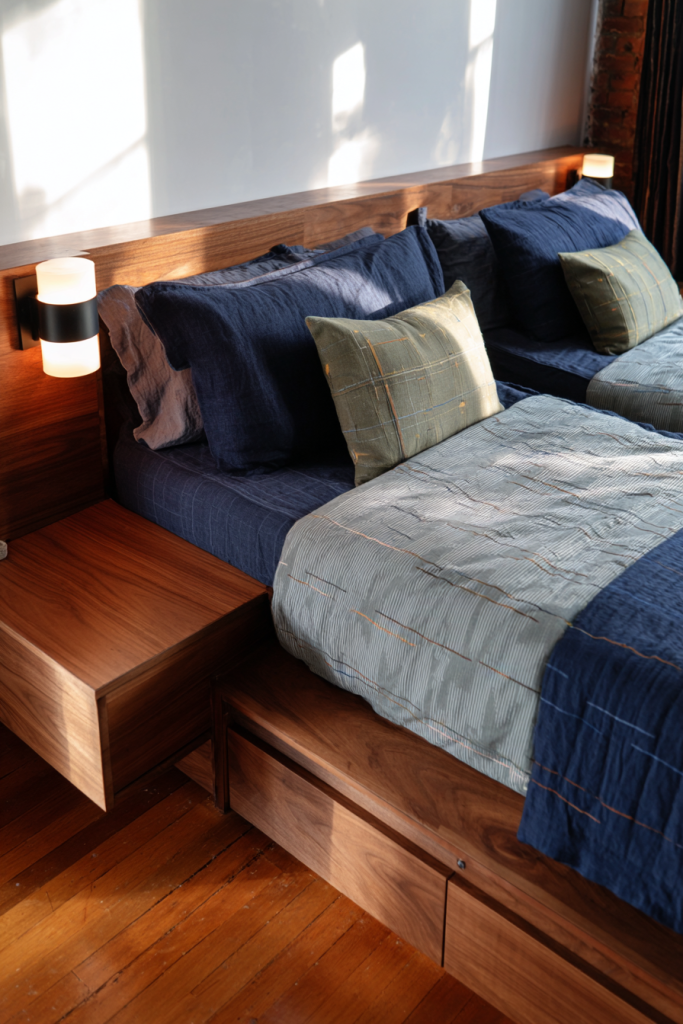
4. Canopy Beds for Privacy and Drama
Canopy beds aren’t just romantic—they’re incredibly practical for shared spaces because they create natural privacy boundaries while adding architectural interest. I’ve used sheer curtains, bamboo panels, or even macramé hangings to define each sleeping area without completely closing off the space. Four-poster beds work beautifully when you have the ceiling height, but even simple canopy frames can transform the room’s ambiance. The key is choosing lightweight, flowing fabrics that can be drawn for privacy or tied back for openness. Consider asymmetrical canopy treatments where each bed has a different but complementary style, such as one with flowing white curtains and another with structured bamboo screens. This creates visual interest while maintaining individual identity within the shared space.
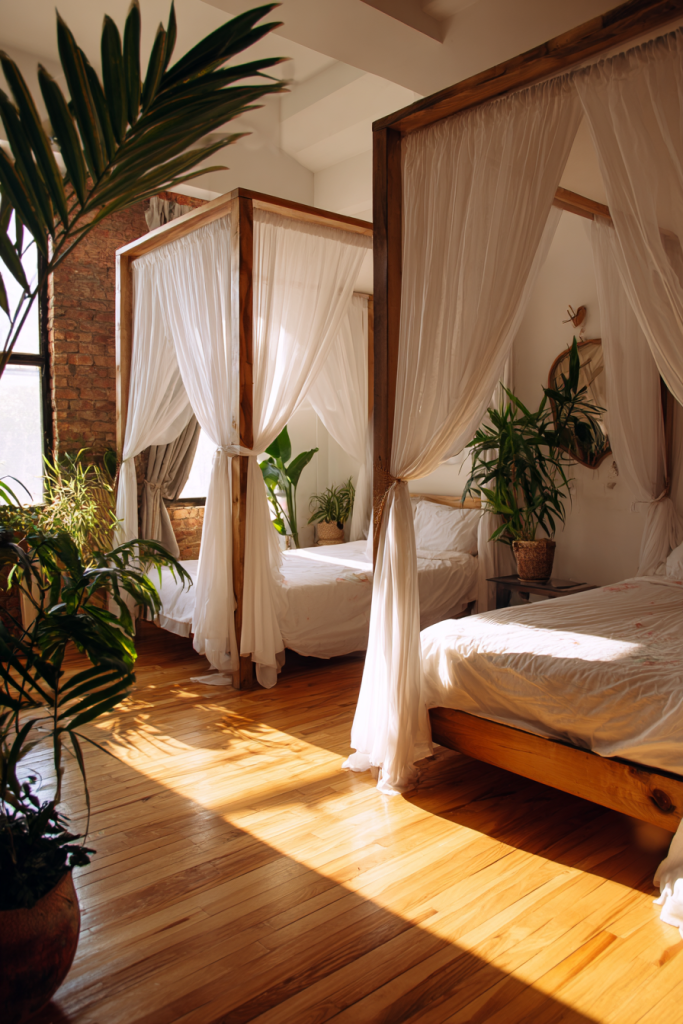
5. Murphy Beds for Ultimate Flexibility
When floor space is at a premium, Murphy beds (wall beds) offer the ultimate flexibility for shared rooms. During the day, you can fold both beds up to create a spacious living area, then pull them down at night for sleeping. Modern Murphy beds come in sophisticated designs that look like built-in cabinetry when closed, often incorporating desks, shelving, or entertainment centers. I particularly love dual Murphy bed setups where each person has their own wall-mounted bed with personalized storage solutions. This approach requires professional installation but transforms even the smallest rooms into multi-functional spaces. Consider models with integrated lighting, soft-close mechanisms, and matching cabinetry that coordinates with your room’s overall design aesthetic for a seamless, custom look.
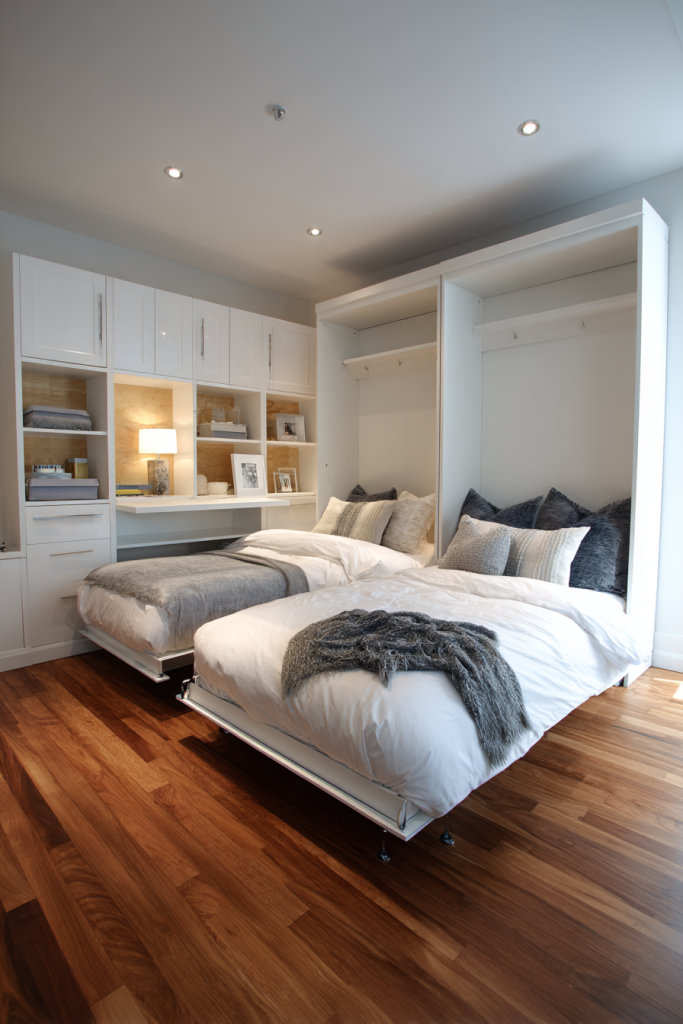
6. Parallel Beds with Central Divider
Creating a symmetrical layout with beds positioned parallel to each other, separated by a central piece of furniture, offers both functionality and visual appeal. I often use a tall bookshelf, room divider, or even a shared dresser as the central element that provides storage while defining each person’s space. This arrangement works beautifully in rectangular rooms and creates a hotel-suite aesthetic. The central divider can house shared items like books, decorative objects, or even a small television that both occupants can enjoy. Consider adding coordinated table lamps on each side for balanced lighting, and use matching bed frames with personalized bedding to maintain harmony while expressing individual style. This layout also allows for easy conversation while respecting personal boundaries.
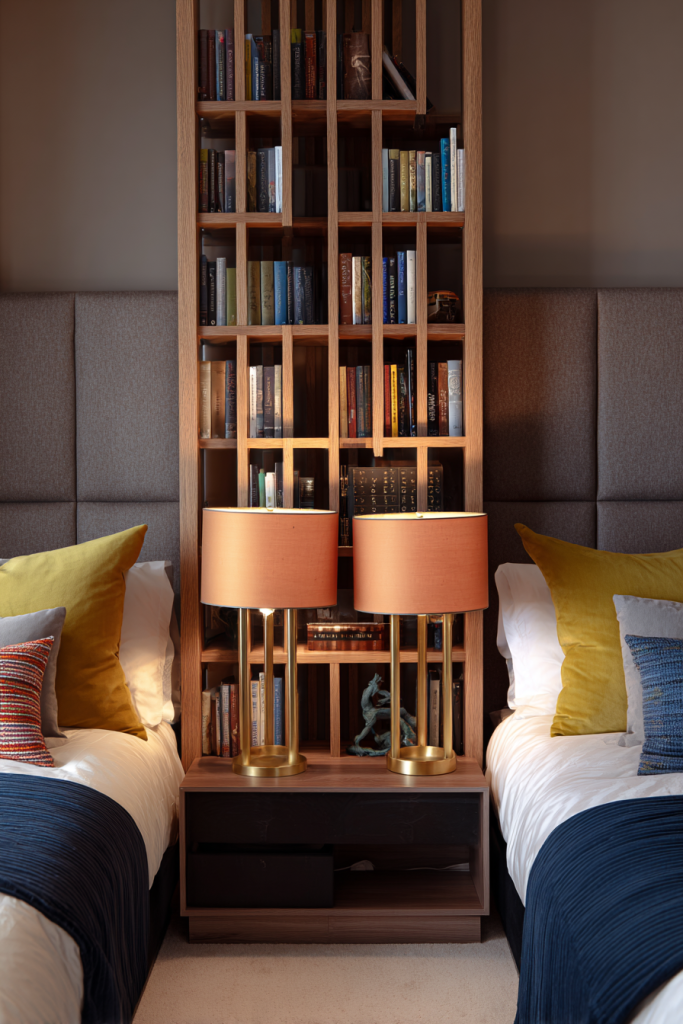
7. Daybed Configuration for Dual Purpose
Daybeds offer incredible versatility in shared spaces because they function as both seating and sleeping areas. I love recommending this approach for rooms that serve multiple purposes throughout the day. Position two daybeds perpendicular to each other or along adjacent walls to create a cozy conversation area during the day that transforms into comfortable sleeping quarters at night. Add plenty of throw pillows and blankets to enhance the lounging experience, and consider daybeds with trundle options for additional sleeping space when needed. This configuration works exceptionally well in studio apartments, guest rooms, or home offices that occasionally need to accommodate overnight visitors. Choose daybeds with sturdy construction and comfortable mattresses that work well for both sitting and sleeping.
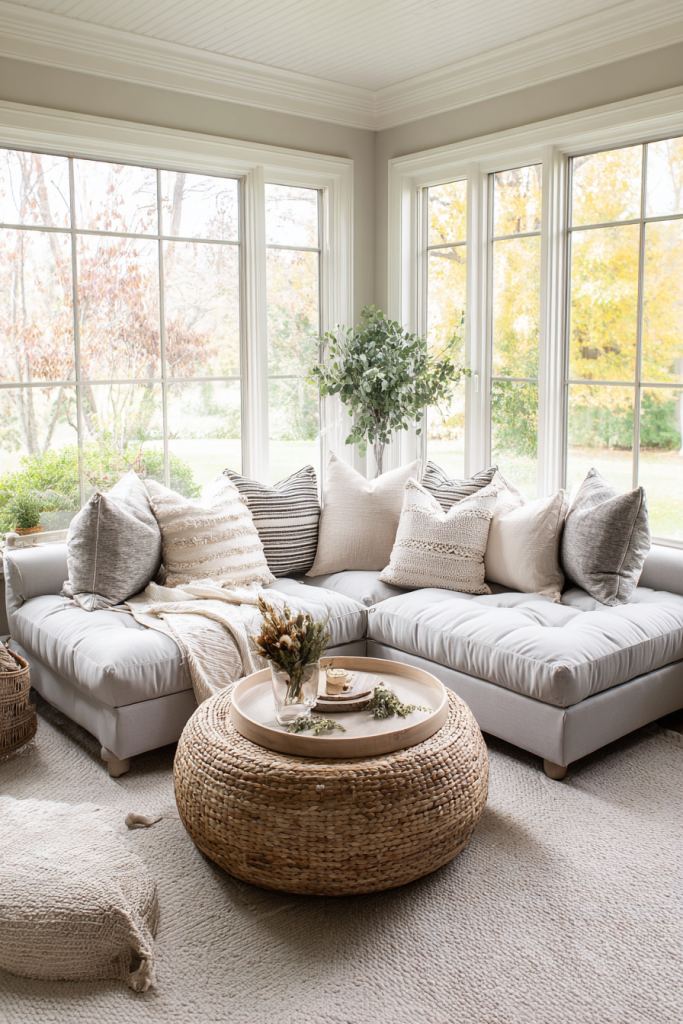
8. Floating Beds for Modern Minimalism
Floating or suspended beds create a striking modern aesthetic while making rooms appear larger by revealing more floor space underneath. This approach works particularly well in contemporary settings where you want to emphasize clean lines and minimal visual weight. I recommend LED strip lighting underneath floating beds for a dramatic nighttime effect that also provides subtle ambient lighting. The key is ensuring proper wall mounting and structural support, especially for adult-sized beds. Consider floating beds at different heights to create visual interest, or use matching heights with different orientations. This modern approach pairs beautifully with floating nightstands and minimalist decor, creating a cohesive, sophisticated look that maximizes the sense of space in shared rooms.
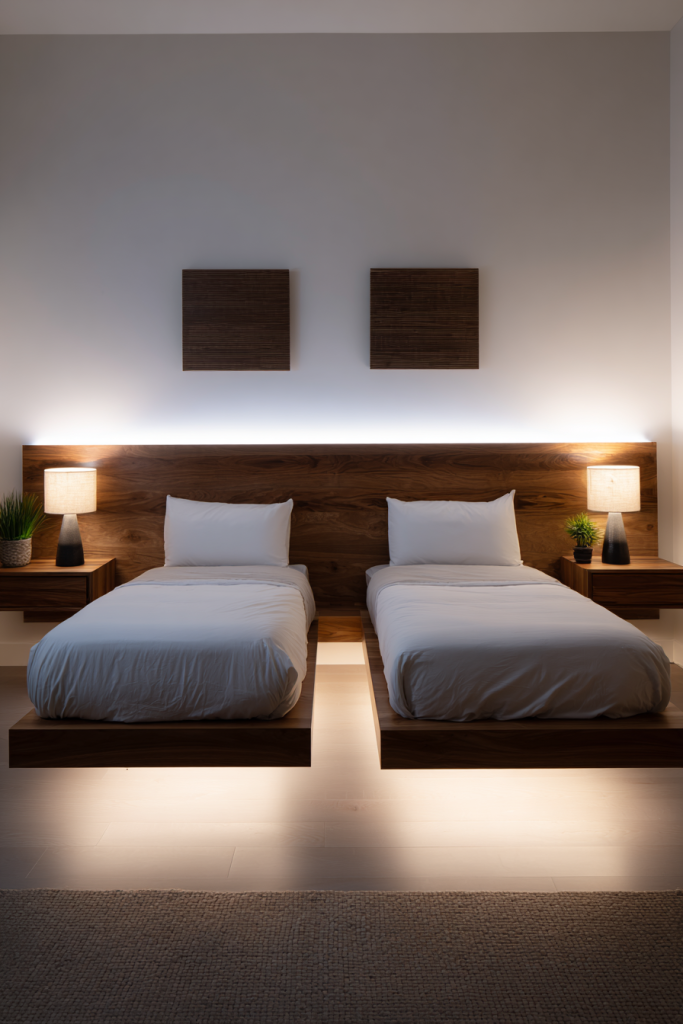
9. Twin XL Beds for Comfort and Space
Twin XL beds offer the perfect compromise between space efficiency and adult comfort, providing extra length that standard twin beds lack. I frequently recommend this size for shared adult bedrooms because they accommodate taller individuals while maintaining a smaller footprint than full-size beds. The additional length makes a significant difference in comfort without overwhelming the room. Position Twin XL beds with strategic spacing to allow for comfortable movement between them, and use the extra floor space for shared furniture like a reading chair or small workspace. This configuration works well with both matching and complementary bed frames, allowing each occupant to express personal style while maintaining proper proportions in the room.
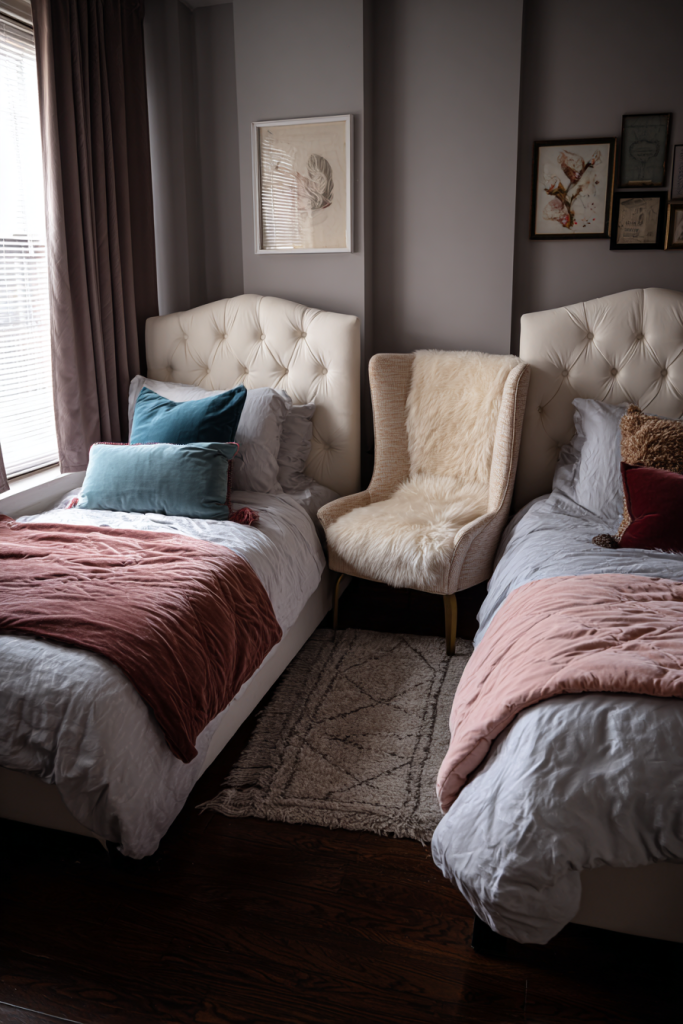
10. Room Divider Integration
Strategic use of room dividers can transform a single bedroom into two semi-private sleeping areas while maintaining the room’s overall flow. I prefer dividers that serve dual purposes, such as bookcases, plant walls, or artistic screens that add beauty while providing function. The key is choosing dividers that don’t completely block light or air circulation. Consider sliding panels, folding screens, or even hanging curtains that can be opened during the day and closed for privacy at night. Translucent materials like frosted glass or bamboo work particularly well because they provide visual separation without making either side feel closed off. This approach allows for greater personalization of each sleeping area while maintaining the room’s architectural integrity.
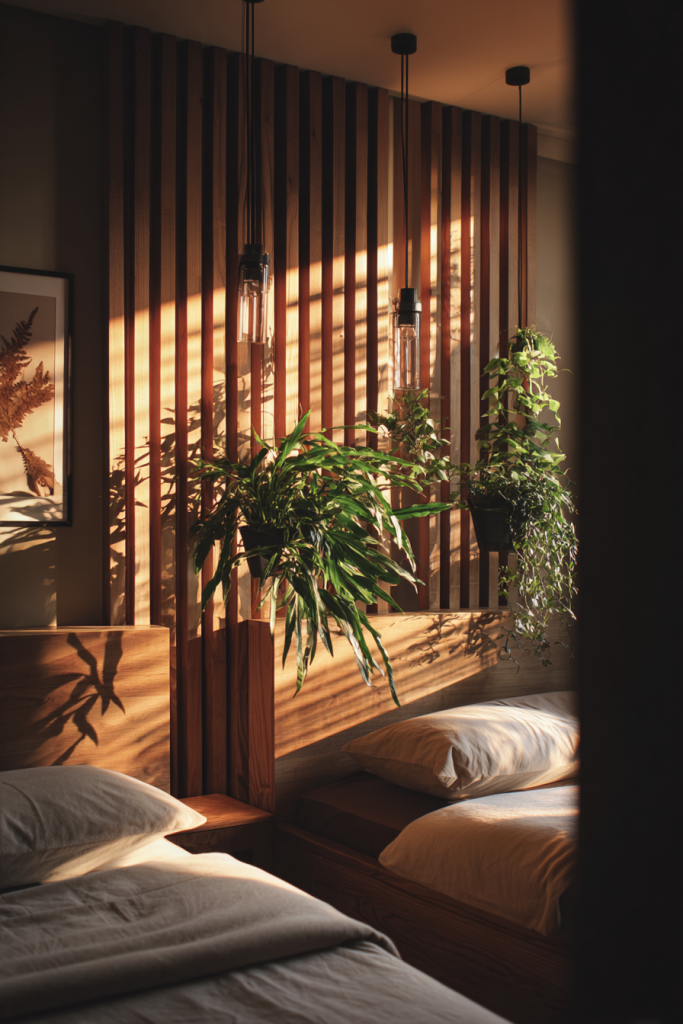
Conclusion
Creating a functional and beautiful shared bedroom with two beds requires thoughtful planning, but the results can exceed your expectations for both style and comfort. The key lies in balancing individual needs with cohesive design, ensuring that each person has their own defined space while maintaining the room’s overall harmony.
Remember that successful dual-bed rooms often incorporate multiple strategies from this list. You might combine storage beds with strategic lighting, or pair a room divider with floating elements to maximize both privacy and visual appeal. The most important consideration is how you and your roommate or partner actually use the space—design should always serve lifestyle, not the other way around.
Whether you’re working with a compact studio or a spacious master bedroom, these approaches prove that sharing sleeping quarters doesn’t mean compromising on style, comfort, or personal expression. With the right planning and design choices, your shared bedroom can become a retreat that works beautifully for everyone involved.
Frequently Asked Questions
Q: How much space do I need between two beds in a shared room? A: I recommend maintaining at least 24-30 inches between beds for comfortable movement, though 36 inches is ideal if space allows. This provides enough room to make beds, access storage, and move around comfortably without feeling cramped.
Q: What’s the best way to provide privacy in a shared bedroom without permanent walls? A: Temporary solutions like curtain panels, folding screens, or tall bookcases work excellently for privacy. Canopy beds with curtains or strategically placed furniture can also create intimate spaces while maintaining the room’s open feel.
Q: How do I coordinate two different personal styles in one bedroom? A: Focus on a unifying element like matching bed frames or a consistent color palette, then allow personalization through bedding, artwork, and accessories. The key is finding common ground in major pieces while expressing individuality in smaller details.
Q: Are bunk beds really practical for adults? A: Modern adult bunk beds are designed with mature users in mind, featuring wider sleeping surfaces, sturdy construction, and sophisticated styling. They’re excellent space-savers, but ensure adequate headroom (at least 30 inches) and consider mobility needs of both users.

